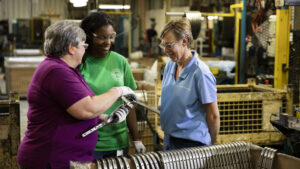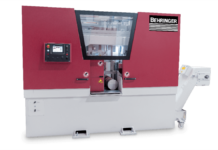 In October, nine new women manufacturing leaders were inducted into the Women in Manufacturing (WiM) Education Foundation Hall of Fame. Nominated by their peers, these women were recognized for their contributions over the course of their careers and their efforts to support the professional growth and success of other women in the sector. The ceremony was part of the 2021 Women in Manufacturing (WiM) SUMMIT in Cleveland, Ohio, which was themed, “Manufacturing HERoes,” in honor of manufacturing leaders who have stepped up during the COVID-19 pandemic by working tirelessly to produce essential products and to help lead a sector that continues to be the backbone of the U.S. economy.
In October, nine new women manufacturing leaders were inducted into the Women in Manufacturing (WiM) Education Foundation Hall of Fame. Nominated by their peers, these women were recognized for their contributions over the course of their careers and their efforts to support the professional growth and success of other women in the sector. The ceremony was part of the 2021 Women in Manufacturing (WiM) SUMMIT in Cleveland, Ohio, which was themed, “Manufacturing HERoes,” in honor of manufacturing leaders who have stepped up during the COVID-19 pandemic by working tirelessly to produce essential products and to help lead a sector that continues to be the backbone of the U.S. economy.
This acknowledgement is all the more critical in light of the impact the COVID-19 pandemic has had on working women. From widespread job losses across industries to the rise of remote work to having to manage virtual learning for our children, how and when Americans across the board are able to plot their careers and make a living has been upended.
And while some of these changes will prove short-term, and others, such as more flexible working options, may well be a positive for workers, there is one trend from the last 18 months that we need to take seriously and course-correct as quickly as possible: the rate at which women left the workforce.
According to the National Women’s Law Center, more than 2.3 million women have left the labor market since March 2020. Even more troubling, one in four working women are considering leaving their job or downsizing their career due to pandemic-induced factors, such as loss of childcare.
When you consider that, today, women make up 47 percent of the U.S. labor force, hold more than half of all U.S. managerial and professional positions, and earn more than half of all associates’, bachelors’, and masters’ degrees in this country, that is a serious blow to our nation’s workforce and economy, not to mention the financial stability and opportunity of American families.
The loss of working women also boils down to dollars and cents. According to McKinsey and Company, employing women in leadership positions helps companies’ bottom lines, and companies that employ women in senior roles consistently financially outperform those with all-male leadership.
 In the manufacturing sector, the loss of highly-educated and accredited workers exacerbates an already significant gender gap. Today, women make up only 29 percent of our domestic manufacturing workforce. If we continue to lose women from these fields, then we run the very real risk of having the backbone of our economy become almost entirely male-dominated. That is not only problematic in principle, but means that an industry that touches nearly every corner of our day-to-day lives is missing out on the insight, experience, and expertise of half of our population.
In the manufacturing sector, the loss of highly-educated and accredited workers exacerbates an already significant gender gap. Today, women make up only 29 percent of our domestic manufacturing workforce. If we continue to lose women from these fields, then we run the very real risk of having the backbone of our economy become almost entirely male-dominated. That is not only problematic in principle, but means that an industry that touches nearly every corner of our day-to-day lives is missing out on the insight, experience, and expertise of half of our population.
That is why it is critical that manufacturing employers take this issue seriously and make proactive steps to recruit, train, and promote women within their companies.
The challenges experienced by women in the manufacturing sector is why WiM is committed to supporting the retention and advancement of our industry’s female workforce.
A challenge facing many women in the workforce is balancing the needs of raising their children with their professional lives. If we are going to reverse the trend of women leaving the workforce, it is critical that working mothers feel that they aren’t alone in balancing the demands of a career with the demands of parenting. That means recognition and support from their employers and colleagues, and it means facilitating opportunities for working mothers to communicate with each other, offer lessons learned, and see that there is a path forward.
 A new WiM initiative is focused on helping women who are facing these challenges of being a working parent. The Moms in MFG community is tailored to support the needs of mothers who work in the manufacturing industry. WiM established this network to support, promote and inspire working moms in manufacturing. WiM’s Moms in MFG community launched in May and the group held its first virtual event in August.
A new WiM initiative is focused on helping women who are facing these challenges of being a working parent. The Moms in MFG community is tailored to support the needs of mothers who work in the manufacturing industry. WiM established this network to support, promote and inspire working moms in manufacturing. WiM’s Moms in MFG community launched in May and the group held its first virtual event in August.
The visibility of women succeeding in the manufacturing sector is an important piece of the puzzle in recruiting and retaining women. It also goes a long way in battling antiquated stereotypes about what it means to work in manufacturing, and what types of job are available.
In short, manufacturing needs better exposure so that younger, female audiences are aware that manufacturing jobs are rewarding, exciting, and lucrative.
This means actively engaging young professionals, but also reaching out to K-12 and college students, because while the number of women graduating college has dramatically increased, the number of women pursuing STEM degrees and careers has not. In fact, a number of recent studies have shown that representation is key to attracting underrepresented demographics, including women, to STEM fields as a whole.
Individual companies can play their part by showcasing more female success stories – from women in senior leadership to engineers to everyday manufacturing workers – to illustrate the variety of ways manufacturing offers reliable and profitable employment with opportunities for growth and development. This will not only help recruit women, but support retaining and advancing workers equipped with the necessary skills to meet the workforce needs of the sector today as well as in the future.
Retaining women in manufacturing is not an issue that rests only on the shoulders of professional women manufacturers or select companies – it is an issue that our industry needs to tackle head-on and holistically given the long-term and intensifying skills gap problem our workforce faces. A 2018 study from Deloitte found that up to half of the millions of manufacturing jobs that will open up this decade will go unfulfilled, largely due to failure to effectively reach out to communities marginalized by the industry.
Failure to reach women, and losing existing women workers, is a financial drain on our sector, and one that, given manufacturing’s role in supporting other sectors of the economy, has a domino effect across the U.S. economy, undermining this country’s competitiveness, innovation, and growth.
WiM is committed to being a part of the solution. Our work is dedicated to supporting the industry in deploying new and creative recruitment methods, providing the infrastructure for the networking and mentorship that allows workers to thrive, and supporting educational and training opportunities. Our goal is to build a diverse, equitable, and inclusive environment for women manufacturing professionals.
While our recent SUMMIT highlighted the fortitude and resilience of women manufacturers during the pandemic, we are now focused on manufacturing’s recovery and our sector’s bright future ahead. We are confident that women are the linchpin to that success, and to mark it we are hosting the first-ever Winter Leadership Conference in St. Pete Beach, Florida early next year.
The experience of the last two years underscored that a company’s most valuable asset is its people. Now more than ever we must re-focus our efforts as an industry on recruiting, retaining, and supporting a workforce more inclusive of women for the benefit of all of us.




















